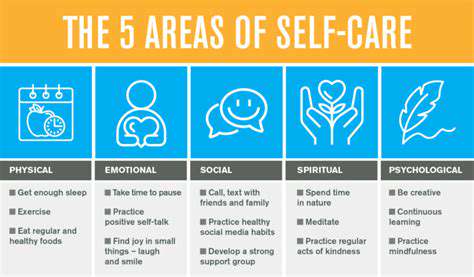Your Personalized Toolkit for Emotional Freedom
Developing Coping Mechanisms: Building Your Emotional Arsenal
Understanding Your Emotional Landscape
To build resilience, start by mapping your emotional responses through introspection. Keeping a handwritten journal often reveals patterns that digital tools miss. Notice how your body reacts to stress - clenched jaws or restless legs often speak louder than words. These physical cues become your early warning system.
Track emotional ebbs and flows like a scientist observing natural phenomena. The rhythm of your reactions holds clues to your unique emotional fingerprint. This observational approach transforms self-awareness from abstract concept to practical tool.
Recognizing and Validating Your Emotions
Emotions function like weather patterns - temporary yet significant. Labeling feelings precisely (is it irritation or rage? Melancholy or grief?) creates emotional clarity. Try the five-why technique: ask why do I feel this? five times to uncover root causes.
Create a personal emotion glossary. For example, your version of anger might actually be disappointment wearing camouflage. This linguistic precision helps dismantle emotional overwhelm into manageable components.
Developing Healthy Stress Management Techniques
Build a personalized stress toolkit combining ancient wisdom and modern science. The 4-7-8 breathing method (inhale 4 counts, hold 7, exhale 8) acts as a physiological reset button. Nature immersion - whether park benches or mountain trails - provides evidence-based stress relief.
Cultivating Mindfulness and Self-Compassion
Practice the STOP technique: Stop, Take a breath, Observe, Proceed. This creates space between stimulus and response. For self-compassion, try writing yourself the letter you'd give your best friend in your situation. The gap between what we'd offer others and what we give ourselves often reveals harsh self-judgment.
Building a Support Network
Quality trumps quantity in support systems. Identify your emotional first responders - those rare individuals who listen without fixing. Reciprocity matters; support networks thrive on mutual exchange, not one-way emotional labor.
Identifying and Challenging Negative Thought Patterns
When catastrophizing, ask What's the actual probability? and What's the most likely outcome? For negative self-talk, collect counter-evidence like a lawyer building a case. Our brains often fixate on failures while ignoring successes - rebalance this tendency consciously.
Practicing Self-Care Rituals
Design micro-rituals that fit your lifestyle. A three-minute tea ceremony or five-minute stretch routine can be more sustainable than elaborate plans. Schedule self-care like critical meetings - because it is. Track how different activities affect your mood to identify what truly replenishes you.
Cultivating Positive Relationships: Building a Supportive Network
Understanding the Importance of Support
Social connections act as emotional shock absorbers. Research shows quality relationships impact longevity more than exercise or diet. The mirror neuron effect means we unconsciously mimic the emotional states of those around us - choose your inner circle wisely.
Identifying Your Needs and Desires
Create a relationship blueprint listing must-haves (trust, respect) and deal-breakers (chronic negativity). Notice which interactions leave you energized versus drained - your body often knows before your mind does.
Nurturing Existing Connections
Practice the three-minute rule - give undivided attention for the first three minutes of any interaction. This builds connection more effectively than hours of distracted time. Remember small details and reference them later - it shows genuine care.
Expanding Your Circle of Influence
Seek weak tie relationships - acquaintances often provide fresh perspectives that close contacts can't. Join groups where you're the novice; learning environments foster authentic connection.
Building Trust and Open Communication
Practice radical candor - caring personally while challenging directly. The trust equation: (Credibility + Reliability + Intimacy) / Self-Orientation. Reduce self-orientation by focusing on mutual benefit.
Practicing Empathy and Compassion
Develop perspective-taking by imagining the other person's backstory. Validate before problem-solving - That sounds really difficult often helps more than immediate advice.
Maintaining Boundaries and Self-Care
Use the billable hours approach to emotional labor - track where you invest energy to identify imbalances. Practice graceful exits: I need to recharge so I can be fully present later maintains relationships while protecting your energy.
Read more about Your Personalized Toolkit for Emotional Freedom
Hot Recommendations
- AI Driven Personalized Sleep Training for Chronic Insomnia
- AI Driven Personalization for Sustainable Stress Management
- Your Personalized Guide to Overcoming Limiting Beliefs
- Understanding Gender Dysphoria and Mental Health Support
- The Power of Advocacy: Mental Health Initiatives Reshaping Society
- Building a Personalized Self Compassion Practice for Self Worth
- The Ethics of AI in Mental Wellness: What You Need to Know
- AI Driven Insights into Your Unique Stress Triggers for Personalized Management
- Beyond Awareness: Actionable Mental Health Initiatives for Lasting Impact
- Creating a Personalized Sleep Hygiene Plan for Shift Workers
